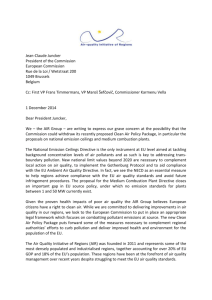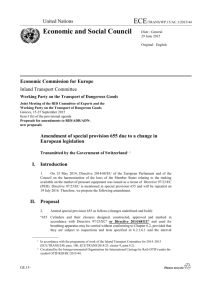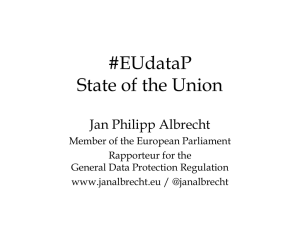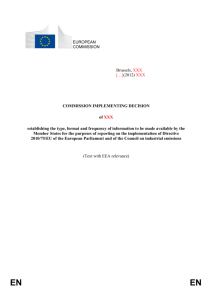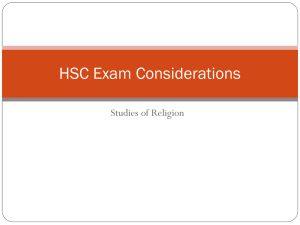limite en
advertisement
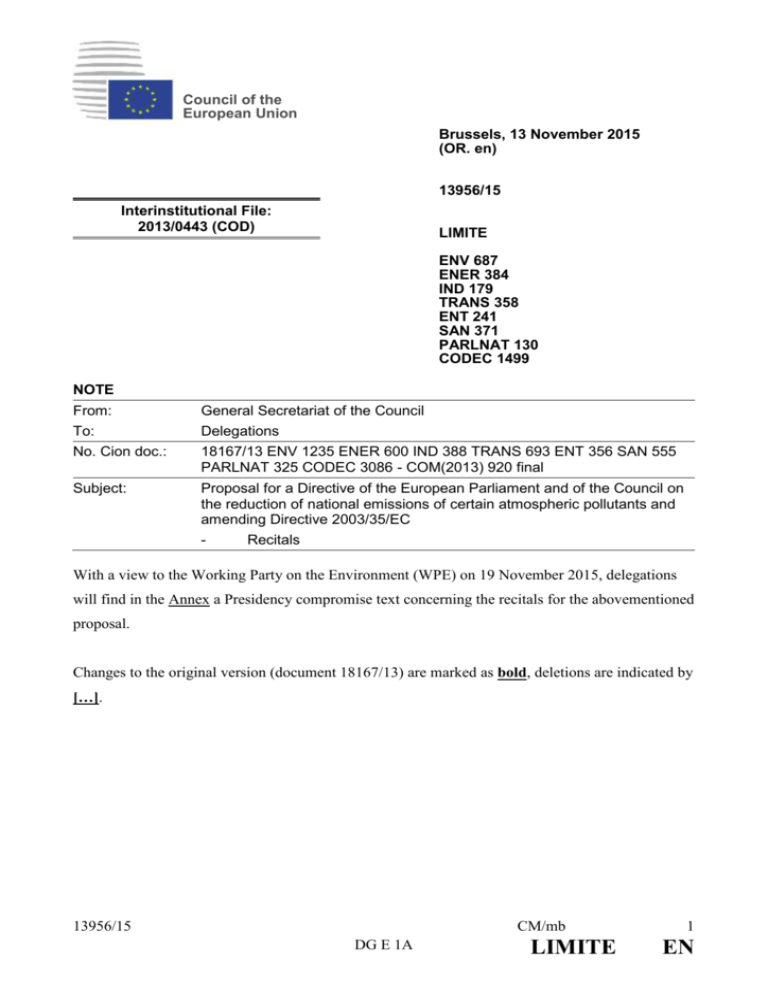
Council of the European Union Brussels, 13 November 2015 (OR. en) 13956/15 Interinstitutional File: 2013/0443 (COD) LIMITE ENV 687 ENER 384 IND 179 TRANS 358 ENT 241 SAN 371 PARLNAT 130 CODEC 1499 NOTE From: To: General Secretariat of the Council Delegations No. Cion doc.: 18167/13 ENV 1235 ENER 600 IND 388 TRANS 693 ENT 356 SAN 555 PARLNAT 325 CODEC 3086 - COM(2013) 920 final Subject: Proposal for a Directive of the European Parliament and of the Council on the reduction of national emissions of certain atmospheric pollutants and amending Directive 2003/35/EC - Recitals With a view to the Working Party on the Environment (WPE) on 19 November 2015, delegations will find in the Annex a Presidency compromise text concerning the recitals for the abovementioned proposal. Changes to the original version (document 18167/13) are marked as bold, deletions are indicated by […]. 13956/15 CM/mb DG E 1A LIMITE 1 EN ANNEX Proposal for a DIRECTIVE OF THE EUROPEAN PARLIAMENT AND OF THE COUNCIL on the reduction of national emissions of certain atmospheric pollutants and amending Directive 2003/35/EC (Text with EEA relevance) THE EUROPEAN PARLIAMENT AND THE COUNCIL OF THE EUROPEAN UNION, Having regard to the Treaty on the Functioning of the European Union, and in particular Article 192(1) thereof, Having regard to the proposal from the European Commission, After transmission of the draft legislative act to the national Parliaments, Having regard to the opinion of the European Economic and Social Committee 1, Having regard to the opinion of the Committee of the Regions 2, Acting in accordance with the ordinary legislative procedure, 1 2 OJ C , , p. . OJ C , , p. . 13956/15 ANNEX CM/mb DG E 1A LIMITE 2 EN Whereas: (1) Significant progress has been achieved in the past 20 years in the Union in the field of anthropogenic air emissions and air quality by a dedicated Union policy, including the 2005 Communication from the Commission "Thematic Strategy on Air Pollution” (“TSAP”) 3. Directive 2001/81/EC of the European Parliament and of the Council 4 has been instrumental in this progress by setting caps on Member States' total annual emissions for 2010 onwards of sulphur dioxide (SO2), nitrogen oxides (NOx), ammonia (NH3) and volatile organic compounds other than methane (NMVOC). As a result, SO2 emissions were reduced by 82%, NOx emissions by 47%, NMVOC emissions by 56% and NH3 emissions by 28% between 1990 and 2010. However, as indicated in the "Clean Air Programme for Europe" ("revised TSAP") 5, significant adverse impacts and risks remain on the environment and human health. (2) The seventh Environment Action Programme 6 confirms the Union's long-term objective for air policy, to achieve levels of air quality that do not give rise to significant negative impacts on and risks to human health and the environment, and calls, to that end, for full compliance with the current air quality legislation of the Union, post-2020 strategic targets and actions, enhanced efforts in areas where the population and ecosystems are exposed to high levels of air pollutants, and reinforced synergies between air quality legislation and Union's policy objectives set for climate change and biodiversity in particular. (3) The revised TSAP sets out new strategic objectives for the period up to 2030 with a view to moving further towards the Union's long-term objective. 3 4 5 6 Communication of 21 September 2005 from the Commission to the Council and the European Parliament "Thematic Strategy on Air Pollution", COM(2005) 446 final. Directive 2001/81/EC of the European Parliament and of the Council of 23 October 2001 on national emission ceilings for certain atmospheric pollutants (OJ L 309, 27.11.2001, p. 22). Communication from the Commission to the Council and the European Parliament "A Clean Air Programme for Europe", COM(2013) [xxx] . Proposal for a Decision of the European Parliament and of the Council on a General Union Environment Action Programme to 2020 "Living well, within the limits of our planet", COM (2012) 710, 29.11.2012. 13956/15 ANNEX CM/mb DG E 1A LIMITE 3 EN (4) Member States and the Union are parties to the 1979 United Nations Economic Commission for Europe Convention on Long-Range Transboundary Air Pollution ("LRTAP Convention") 7 and to several of its Protocols, including the 1999 Gothenburg Protocol to Abate Acidification, Eutrophication and Ground-level Ozone. (5) As regards the year 2020 and thereafter, the revised Gothenburg Protocol […] sets out new emission reduction commitments, taking the year 2005 as a base year, for each party regarding SO2, NOx, NH3, NMVOC and fine particulate matter (PM2,5), promotes emission reductions of black carbon and calls for the collection and keeping of information on the adverse effects of air pollutant concentrations and depositions on human health and the environment and participation in the effects-oriented programmes under the LRTAP Convention. (6) The national emission ceiling regime established by Directive 2001/81/EC should therefore be revised in order to align it with the international commitments of the Union and the Member States. To that effect, the national emission reduction commitments for any year from 2020 to 2029 in this Directive are identical to those set in the revised Gothenburg Protocol. (7) Member States should implement this Directive in a way that contributes effectively to the meeting of the Union's long-term objective on air quality as supported by the guidelines of the World Health Organisation and of the Union's biodiversity and ecosystem protection objectives by reducing the levels and deposition of acidifying, eutrophifying and ozone air pollution below critical loads and levels as set out by the LRTAP Convention. (8) This Directive should also contribute to the achievement of the air quality objectives set in Union legislation and to the mitigation of climate change impacts […] as well as to the improvement of air quality globally. 7 Council Decision 2003/507/EC of 13 June 2003 on the accession of the European Community, to the Protocol to the 1979 Convention on Long-Range Transboundary Air Pollution to Abate Acidification, Eutrophication and Ground-Level Ozone (OJ L179, 17.7.2003, p. 1). 13956/15 ANNEX CM/mb DG E 1A LIMITE 4 EN (9) Member States should comply with the emission reduction commitments set out in this Directive from […] 2020 and from 2030. So as to ensure demonstrable progress towards the 2030 commitments, Member States should identify […] intermediate emission levels in 2025 which would be technnically feasible and not entail disproportionate costs, and endeavour to comply with such levels […]. Where the 2025 emissions cannot be so limited, Member States should explain the reasons in their reports under this Directive. (9a) The national emission reduction commitments set out in this Directive for 2030 onwards are based on the estimated reduction potential of each Member State contained in the TSAP Report 16 of January 2015, on technical examination of the differences between national estimates and those in TSAP 16, and on the political objective to maintain the overall health impact reduction by 2030 (compared with 2005) at close to the 52% in the original Commission proposal. (10) Reporting requirements and emission reduction commitments should be based on national energy consumption and fuel sold. However, some Member States may opt […] under the LRTAP Convention to use the national emission total calculated on the basis of fuels used regarding the road transport sector as a basis for compliance. This option should be kept in order to ensure coherence between International and European legislation […]. 13956/15 ANNEX CM/mb DG E 1A LIMITE 5 EN (11) This Directive should leave Member States certain flexibility in complying with their emission reduction commitments. To this effect, in case of improved scientific understanding and methodologies regarding emissions, Member States should be allowed to adjust their national emission inventories. In this context, it is recalled that the reduction commitments for the years 2020 to 2029 are identical to those set on 4 May 2012, when the relevant provisions of the Gothenburg Protocol were amended. Moreover, in order to promote cost-effective achievement of the national emission reduction commitments […], Member States should be entitled to average their national annual emissions for a maximum of three years in case of a particularly cold winter, a particularly dry summer, or unforeseen variations in economic activities […]. Member States should also be deemed to comply with their emission reduction commitments for a limited number of years, in case of sudden and exceptional events related to energy generation or supply and provided that specific conditions are met […]. The Commission should monitor […] the use of any of these flexibilities by a Member State and object to it where it considers […] the conditions set out in this Directive not to be met. (12) Member States should adopt and implement a national air pollution control programme with a view to meeting their emission reduction requirements […], and to contributing effectively to the achievement of the Union air quality objectives. To this effect, Member States should take account of the need to reduce emissions in zones and agglomerations affected by excessive air pollutant concentrations and/or in those that contribute significantly to air pollution in other zones and agglomerations, including in neighbouring countries. National air pollution control programmes should, to that end, contribute to the successful implementation of air quality plans enacted under Article 23 of Directive 2008/50/EC of the European Parliament and of the Council 11. 11 Directive 2008/50/EC of the European Parliament and of the Council of 21 May 2008 on ambient air quality and cleaner air in Europe (OJ L 152, 11.6.2008, p. 1). 13956/15 ANNEX CM/mb DG E 1A LIMITE 6 EN (13) In order to reduce atmospheric NH3 and PM2,5 emissions from the main contributors, national air pollution control programmes should include measures applicable to the agricultural sector. Member States should be entitled to implement measures other than those set out in this Directive with an equivalent level of environmental performance owing to specific national circumstances. (14) The national air pollution control programme, including the analysis supporting the identification of policies and measures, should be regularly updated. (15) In order to draw up well informed national air pollution control programmes and any significant updates, Member States should make those programmes and updates subject to consultation by the public and competent authorities at all levels when all options regarding policies and measures remain open. Member States should engage in transboundary consultations in case where the implementation of their programme could affect air quality in another country, in accordance with the requirements set out in Union and international legislation, including the Convention on Environmental Impact Assessment in a Transboundary Context (Espoo, 1991) and its Protocol on Strategic Environmental Assessment (Kyiv, 2003), as approved by the Council 12. (16) Member States should establish and report emission inventories, projections and informative inventory reports for all air pollutants covered by this Directive, which should then enable the Union to meet its reporting duties under the LRTAP Convention and its Protocols. (17) In order to preserve overall consistency for the Union as a whole, Member States should ensure that their reporting to the Commission of their national emission inventories, projections and informative inventory are fully consistent with their reporting under the LRTAP Convention. 12 Council Decision 2008/871/EC of 20 October 2008 on the approval, on behalf of the European Community, of the Protocol on Strategic Environmental Assessment to the 1991 UN/ECE Espoo Convention on Environmental Impact Assessment in a Transboundary Context (OJ L 308, 19.11.2008, p. 33). 13956/15 ANNEX CM/mb DG E 1A LIMITE 7 EN (18) In order to assess the effectiveness of the national emission reduction commitments laid down in this Directive, Member States should also monitor […] the effects of such reductions in terrestrial and aquatic ecosystems, taking into account the costs and benefits […] and report these effects. (19) In line with Directive 2003/4/EC of the European Parliament and of the Council 13, Member States should ensure active and systematic dissemination of information by electronic means. (20) It is necessary to amend Directive 2003/35/EC of the European Parliament and of the Council 14 with a view to ensuring consistency of this Directive with the 1998 Aarhus Convention on Access to Information, Public Participation in Decision-Making and Access to Justice in Environmental Matters. (21) In order to take into account technical and international developments, the power to adopt acts in accordance with Article 290 of the Treaty on the Functioning of the European Union should be delegated to the Commission in respect of amending […] Annex I, as well as Part […]2 of Annex III and Annex IV to adapt them to developments within the framework of the LRTAP Convention and amending Annex V to adapt […] it to technical progress. It is of particular importance that the Commission carry out appropriate consultations during its preparatory work, including at expert level. The Commission, when preparing and drawing up delegated acts, should ensure a simultaneous, timely and appropriate transmission of relevant documents to the European Parliament and to the Council. 13 14 Directive 2003/4/EC of the European Parliament and of the Council of 28 January 2003 on public access to environmental information (OJ L 41, 14.2.2003, p. 26). Directive 2003/35/EC of the European Parliament and of the Council of 26 May 2003 providing for public participation in respect of the drawing up of certain plans and programmes relating to the environment and amending with regard to public participation and access to justice Council Directives 85/337/EEC and 96/61/EC (OJ L156, 25.6.2003, p. 17). 13956/15 ANNEX CM/mb DG E 1A LIMITE 8 EN (22) In order to ensure uniform conditions for the implementation of Articles 5, 6 and 9(4) of this Directive, implementing powers should be conferred on the Commission. Those powers should be exercised in accordance with Regulation (EU) No 182/2011 of the European Parliament and of the Council 15. (23) Member States should lay down rules on penalties applicable to infringements of the national provisions adopted pursuant to this Directive and ensure that they are implemented. Those penalties should be effective, proportionate and dissuasive. (24) With a view to the nature and extent of the modifications which should be made to Directive 2001/81/EC, that Directive should be replaced to enhance legal certainty, clarity, transparency and legislative simplification. In order to ensure continuity in improving air quality, Member States should comply with the national emission ceilings set out in Directive 2001/81/EC until the new national emission reduction commitments laid down in this Directive become applicable in 2020. (25) Since the objective of this Directive, namely to ensure a high level of protection of human health and the environment, cannot be sufficiently achieved by Member States, but can rather, by reason of the transboundary nature of air pollution, be better achieved at Union level, the Union may adopt measures in accordance with the principle of subsidiarity as set out in Article 5 of the Treaty on European Union. In accordance with the principle of proportionality, as set out in that Article, this Directive does not go beyond what is necessary in order to achieve that objective. 15 Regulation (EU) No 182/2011 of the European Parliament and of the Council of 16 February 2011 laying down the rules and general principles concerning mechanisms for control by the Member States of the Commission’s exercise of implementing powers (OJ L 55, 28.2.2011, p. 13). 13956/15 ANNEX CM/mb DG E 1A LIMITE 9 EN (26) In accordance with the Joint Political Declaration of Member States and the Commission of 28 September 2011 on explanatory documents 16, Member States have undertaken to accompany, in justified cases, the notification of their transposition measures with one or more documents explaining the relationship between the components of a directive and the corresponding parts of national transposition instruments. With regard to this Directive, the legislator considers the transmission of such documents to be justified. HAVE ADOPTED THIS DIRECTIVE: 16 OJ C 369, 17.12.2011, p. 14. 13956/15 ANNEX CM/mb DG E 1A LIMITE 10 EN
